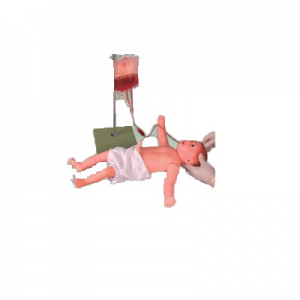ADA MED SUPPLY LIMITED
Phone:+86 19937901373
Tel:+86-0379-65160607
Email:adaanatomy@adaanatomy.com


Infant venipuncturing is a key skill in clinical emergency and routine care, especially in the care of newborns or premature infants. However, infantile venipentesis is more difficult, mainly because infantile blood vessels are small, soft, and difficult to locate. In this case, the use of infant whole-body venipunction models for training is particularly important. However, whether the existing model can effectively simulate the variable factors in the actual clinical environment is a question worthy of further discussion.
1. Variability of blood vessels :
Compared with adults, the venous vessels of infants are more fragile and small, and the size, depth and direction of the blood vessels of infants at different ages are significantly different. The traditional training model can only simulate a single type of blood vessel structure, which is difficult to reflect the dynamic changes of blood vessels. In clinical practice, medical personnel often need to face babies of different ages, different weights, and even different pathological conditions, and blood vessels may change due to dehydration, low blood pressure, fever and other factors.
2. Fine requirements of puncture technology :
Venipuncture in infants requires extreme skill, as the doctor needs to accurately locate the blood vessels and ensure that the puncture depth and Angle are appropriate. Traditional models often lack the simulation of subtle pressure perception and feedback during the piercing process, resulting in medical personnel can not feel the real operating resistance and touch.
Data Support : According to a 2019 study, participants who trained with a high-simulation model for infantile venipentesis had a success rate approximately 25% higher than those who used a traditional model. The high simulation model can better simulate vascular elasticity, puncture resistance, and blood flow feedback to help students improve their practical skills.
3. Emergency response capacity :
In the clinic, infantile venipentesis often needs to be completed in a very short period of time, especially in the case of acute dehydration or hypoglycemia in the infant. Existing venipentesis models often lack sufficient situational simulation ability when simulating variable factors (such as family interference, equipment failure, etc.) in high-pressure environment.
Industry expert analysis : Experts say that high simulation can help medical personnel feel clinical pressure in a simulated environment, providing more opportunities for emergency response. For example, through situational simulations, medical staff can experience how to quickly assess vascular conditions and adjust operations in an emergency.
Conclusion
Although existing models of systemic venipentesis in infants provide a necessary training opportunity for medical personnel, traditional models still have certain limitations in simulating the variable factors in actual clinical Settings. With the development of high simulation technology, the training model can more truly reflect the vascular variability, the fine requirements of puncture operation and the emergency situation, so as to help medical staff improve the clinical response ability. Therefore, the future training model should be developed in the direction of more simulation and dynamic simulation, so as to better meet the practical needs of clinical practice.